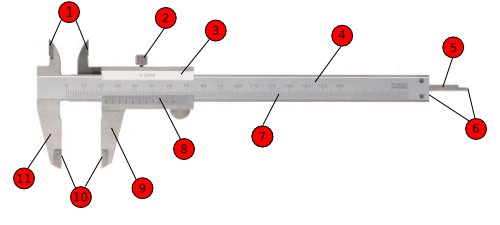A Caliper is simply a measuring device from a compass to intense instruments such as the vernier caliper acting as an advanced ruler. The vernier caliper uses vernier scale to measure more precisely. This instrument provides different methods of measuring including ways to measure external or internal dimensions as well as finding depth measurements. In fact the depth measurement method of using a movable and slidable probe is so slender that it is able to retrieve data in deep canals.
You have to be familiar with the instrument in order for your to achieve an accurate measurement. Any discrepancy from of measurement even for just a few millimeters will spell success of trouble for you. Machinist are experts on this device. But evenso, they still need to exercise caution.The lower and upper section of this scale generally uses both inch and metric measurements. Industries use vernier calipers because of its hundredth of a millimeter precision equal to one thousandth of an inch. Below describes the vernier caliper's parts and functions.

The rail (4) allows sliding to occur on the main scale (7) moving the vernier scale (3) while the fixed jaw (11) remains in place so the precise measurement is found. Also, draw back and forth (9) the instrument's jaws (parts 1 and 10) to adjust the caliper. The indicated measurement is found at the left of the vernier scale (3 and 8) either in inches or centimeters. The sliding jaw (9) and the depth probe (5) are connected to and move along with the vernier scale. Deep measurements are taken by the use of the front end of the rail (6).
- Inside jaws: Internal length measurements are found by using this part.
- Retainer or locking screw: This part blocks the instrument's movable parts in order to transfer between measurement methods easily.
- Vernier scale (inch)
- Rail (inch)
- Depth probe: The part used in order to find depth measurements
- Front end of the rail
- Main scale (mm)
- Vernier scale (mm)
- Sliding Jaw
- Outside jaws: This part makes measuring external lengths possible.
- Fixed Jaw
source



What a nice site you got here. Please do join and follow me at my blog at http://www.jr041283.com I will be happy to exchange links with you. Thank. Keep if up.
ReplyDeleteWe are a leading manufacturer & exporter company offering a wide range of heavy duty machinery such as lathe machines, heavy duty lathe machine, extra heavy duty lathe machine, heavy duty roll turning lathe machine, hydraulic power hacksaw machine, all geared lathe machine and vertical turning lathe machine at affordable prices in India.
ReplyDeleteHeavy Duty Lathe Machine
Nice blog dear I like the way as you present your view among the all visitors. I would like to join you again on this blog it’s a very nice visit on this blog. It’s very attractive and effective for visitors. Pressure Die Casting Machines, Aluminium Components
ReplyDeleteInteresting blog and its great resource many people, because its having the useful message.
ReplyDeleteHome health care provider
Verniercalipers Then the user has to note down the value of measurements on the main scale and the Vernier scale. User can use a simple formula and substitute the values of measurement in the formula to get a 100% accurate measurement of the object placed between the jaws of the device.
ReplyDelete